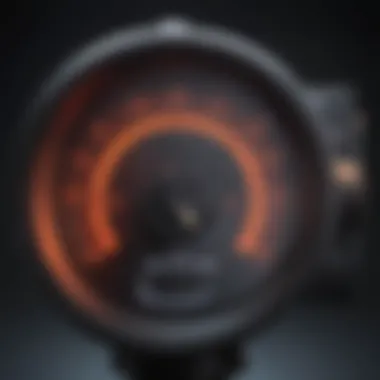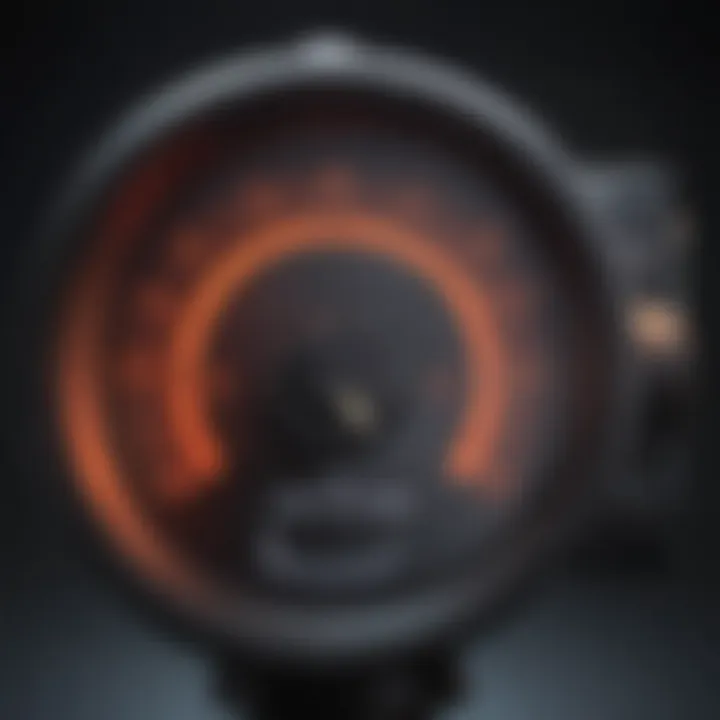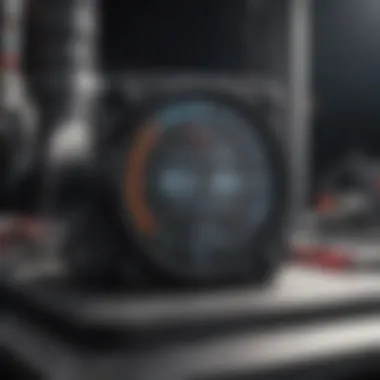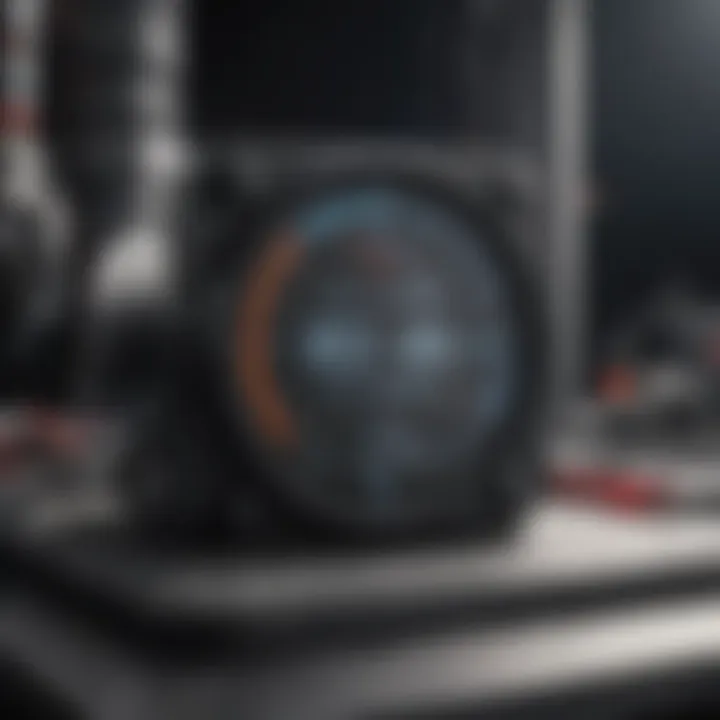Exploring Non-Contact Temperature Measurement Techniques


Intro
The art of measuring temperature has taken significant leaps over the years. Particularly, non-contact temperature measurement techniques have emerged as vital tools in both scientific and everyday applications. This method allows for temperature assessments without the need to touch the object being measured. Such techniques became ever more relevant with the rise of health awareness, especially during times of health crises where contact-based measurement was not feasible. As we'll investigate in detail, these methods not only safeguard health but also enhance precision in various industries.
When we talk about non-contact temperature measurement, we often think of advanced devices like infrared thermometers or thermal cameras, but the underlying principles date back to notable scientific advances and discoveries. Grasping the history and evolution of these techniques provides insight into why they are so crucial and prevalent today.
In this exploration, we will touch on key devices that have revolutionized this field, delve into their applications across various sectors, and examine the technological advancements that contribute to their effectiveness. By providing a comprehensive overview, this discussion aims to shed light on the impacts and implications these non-contact methods have across diverse disciplines and everyday life.
Intro to Non-Contact Temperature Measurement
In an age where precision and efficiency hold paramount importance, non-contact temperature measurement emerges as a vital technique across a multitude of fields. This section delves into the essence of non-contact temperature measurement, articulating its relevance and the profound impacts it has made in both scientific and applicable realms.
Definition and Overview
Non-contact temperature measurement involves techniques that allow the assessment of temperature without physical contact with the object under observation. This is primarily achieved through the principles of thermal radiation, where devices interpret the infrared radiation emitted by an object’s surface to derive its temperature. The non-invasive nature of these measurements holds several advantages.
- Safety: Measuring temperatures from a distance can be crucial in hazardous environments, such as in industrial settings or when dealing with potentially infectious individuals in healthcare.
- Efficiency: These techniques enable rapid assessments, making them indispensable in scenarios requiring quick decision-making, such as during surgical procedures or monitoring equipment in real-time.
The simplicity of using these devices adds to their appeal, allowing for swift application without complex setup processes.
Historical Context
The journey of non-contact temperature measurement began humbly, yet it has shaped modern science and technology. Early discoveries in infrared thermometry identified infrared radiation as not just a curiosity, but a useful tool. Around the 19th century, scientists such as William Herschel started to explore the infrared spectrum, paving the way for future advancements in temperature evaluation techniques.
The introduction of modern infrared thermometers in the mid-20th century revolutionized temperature readings in both industrial and medical settings. As technology progressed, these devices evolved with advancements in sensor technology, resulting in a wider array of applications ranging from preventive maintenance to surgical interventions.
Importance in Modern Science
The relevance of non-contact temperature measurement in contemporary science cannot be overstated. In light of the global health crisis, its application in fever screening has been spotlighted significantly. Hospitals and airports worldwide have adopted infrared thermometers to prevent the spread of contagious diseases, showcasing the method’s utility in real-time monitoring of body temperature.
In addition, industries have taken advantage of these tools for process control and quality assurance. Manufacturing processes where precise temperature control is essential can benefit enormously from real-time temperature monitoring, facilitating optimal operating conditions for machinery and products.
Furthermore, advancements in non-contact temperature measurement technology continue to push boundaries in research fields, aiding scientists in improving data accuracy in material testing and environmental studies.
"Non-contact temperature measurement techniques are not only changing how we approach various industries but are also setting the stage for more innovative solutions in the future."
This section serves as an introduction to the key components that hinge upon non-contact measurement techniques, representing an evolving field that is constantly adapting to meet the demands of science and industry alike.
Operating Principles of Non-Contact Temperature Measurement
Understanding the operating principles of non-contact temperature measurement is foundational for grasping how these techniques function in various applications. Non-contact methods leverage the thermal radiation emitted by an object to determine its temperature without any physical interaction. This approach proves invaluable across multiple disciplines, from healthcare to industrial processes, providing a safer and more efficient means of thermal assessment.
Basics of Thermal Radiation
Thermal radiation is the process through which heat is emitted by objects in the form of electromagnetic waves. Every object with a temperature above absolute zero emits energy as infrared radiation. The amount and intensity of this radiation increase with temperature. This means that hot objects radiate more energy than cooler ones. It's a little like the glow of a fire: as the flame burns hotter, it sends out waves of heat every which way.
In practical terms, this property allows us to measure temperature without needing to touch the object. Different materials might emit different amounts of radiation, which ties into something known as emissivity—a ratio that measures how efficiently a surface emits radiation compared to a perfect black body. Recognizing emissivity is crucial, as it significantly affects the accuracy of temperature readings in any given context.
Planck's Law and Its Relevance
Planck's Law describes how the intensity of radiation emitted by a black body at a given temperature varies with wavelength. It provides the theoretical basis for understanding thermal radiation. According to the law, the energy emitted increases with temperature but varies across wavelengths, peaking at specific points dependent on the temperature itself.
The application of Planck's Law in non-contact thermometers allows these devices to interpret the thermal signals they're receiving correctly. In simpler terms, it helps the thermometer translate the infrared light it detects into a corresponding temperature reading, making it versatile and especially relevant in situations where physical contact isn't possible—such as measuring a fever in a patient or monitoring hot equipment in an industrial setting.
Key Parameters Affecting Measurement
Several crucial parameters influence the effectiveness and accuracy of non-contact temperature measurement:
- Distance: The distance between the thermometer and the object can lead to discrepancies in measurement. The further away you measure, the less accurate it may become due to atmospheric interference.
- Emissivity: As mentioned earlier, different materials emit radiation differently. Knowing or adjusting for emissivity allows for more precise readings. In general, black or dark surfaces emit radiation more effectively than shiny, reflective materials.
- Environmental Conditions: Factors like humidity, dust, or smoke can scatter the thermal radiation, leading to less accurate results. The more obstructions present, the more potential for error.
To summarize, being aware of these parameters and their interplay can greatly enhance the reliability of non-contact temperature measurements.
"Understanding the principles of thermal radiation and the laws governing it allows practitioners to utilize non-contact measurement techniques to their utmost potential, ensuring precise and reliable readings across various applications."
By keeping these principles in mind, users can make informed decisions about the right instruments to use and the conditions they must control to achieve the accuracy they need.
Types of Non-Contact Temperature Measurement Devices
In the realm of temperature measurement, non-contact methods have carved out a significant niche due to their versatility and ease of use. Understanding the different types of devices available is crucial for professionals and researchers alike, as it influences decision-making processes in various applications. Each device offers specific advantages that can be pivotal in fields ranging from healthcare to industrial monitoring.


Infrared Thermometers
Working Mechanism
Infrared thermometers function by capturing the infrared radiation emitted by objects and converting that energy into a temperature reading. They typically utilize infrared sensors, which detect the heat radiated from surfaces, enabling users to obtain readings without physical contact. This method stands out because it allows quick measurements, making it ideal for scenarios where time is critical.
One key characteristic of infrared thermometers is their ability to measure temperatures at a distance—this can be particularly beneficial in high-temperature environments where direct contact is unsafe. A unique feature of modern infrared thermometers is their laser targeting, which enhances accuracy by indicating the area being measured. However, users must be mindful of emissivity variations in different materials, which can affect accuracy.
Applications and Benefits
The applications for infrared thermometers span various fields, including medical diagnostics and culinary arts. In healthcare, they are often employed for fever screening, providing rapid results without patient discomfort. This non-invasive option is particularly relevant in today's context of public health awareness.
The main advantage of infrared thermometers is their speed and ease of use, making them a popular choice for initial temperature assessments. However, while they are effective for surface temperature monitoring, they may be less reliable for deeper or internal measurements. Understanding the context in which these devices are used is essential for researchers and practitioners alike.
Thermal Imaging Cameras
Principles of Operation
Thermal imaging cameras take the concept of temperature measurement a step further by capturing the thermal radiation of an object and translating it into a visual representation. These cameras convert infrared radiation into electronic signals, which are then processed to generate an image where different colors represent various temperatures. This visual output allows users to identify temperature anomalies quickly, which can be crucial in fields like building inspection and safety monitoring.
A significant characteristic of thermal imaging cameras is their ability to visualize heat patterns across an area. This unique feature provides unparalleled insight into temperature distribution, leading to more informed decisions in maintenance and troubleshooting. However, the initial investment in these cameras can be high, posing a challenge for smaller organizations.
Industrial and Medical Applications
Thermal imaging finds extensive use in both industrial and medical settings. In industry, these cameras are invaluable for predictive maintenance, as they can detect overheating equipment before failure occurs. This proactive approach can save companies significant downtime and repair costs.
In the medical field, thermal imaging cameras are utilized for diagnostic purposes, enabling the non-invasive assessment of conditions like inflammation or circulatory issues. The advantage here is clear: early detection can lead to timely medical intervention. On the flip side, the interpretation of thermal images requires specialized training, which can be a limiting factor for widespread adoption.
Pyranometers and Pyrgeometers
Measurement of Solar Radiation
Pyranometers and pyrgeometers are specialized instruments designed to measure solar radiation. Pyranometers assess total solar radiation from the entire hemisphere, while pyrgeometers focus specifically on infrared radiation emitted from the earth and atmosphere. Understanding their functionalities is important for researchers studying climatic effects and energy dynamics.
A notable feature of these devices is their sensitivity to both direct and diffuse solar radiation, which is instrumental in solar energy applications. They often feature excellent calibration stability, ensuring accuracy over extended periods. However, their efficacy can degrade in extreme weather conditions, warranting caution in data interpretation.
Usage in Meteorology
In meteorological research, pyranometers and pyrgeometers play a crucial role in evaluating solar energy potential and climate modeling. Their measurements are pivotal for forecasting weather conditions and studying environmental changes over time.
Moreover, these instruments contribute to the development of solar energy systems by informing the placement and efficiency of solar panels. However, while they provide essential data, the complexity of installation and maintenance may deter some users. Hence, knowledge and expertise are necessary for optimal utilization in both meteorological and energy sectors.
Calibration and Accuracy in Non-Contact Measurements
Calibration and accuracy are the backbone of any measurement system, especially in non-contact temperature measurement, where precise data is critical. Without reliable calibration, readings can drift, leading to potential misjudgments in various applications such as healthcare, manufacturing, or scientific research. The worth of a non-contact device lies not just in its technology, but in its verified calibration processes and methods that ensure data integrity. As we explore this section, consider calibration as a quality assurance measure, safeguarding the credibility of measurements in a world that increasingly relies on data-driven decisions.
Importance of Calibration
Calibration can be seen as the benchmark for establishing the reliability of measuring devices, bridging the gap between a device's output and known reference standards. For non-contact temperature measurement tools, calibration serves several critical functions:
- Ensures Accuracy: Regular calibration helps in eliminating errors that could arise from device drift or environmental factors.
- Enhances Consistency: Frequent checks lead to more consistent readings across different devices, vital in multi-device environments.
- Increases Trust: Trust in a temperature reading, whether in a hospital or an industrial facility, stems from a strong calibration protocol.
When calibrating non-contact thermal devices, factors like emissivity and environmental conditions come into play. This intricate balance can highlight the necessity for manufacturers and users alike to prioritize calibration routines.
Calibration Methods
Several methods can be employed to calibrate non-contact temperature measurement devices:
- Comparison Calibration: This involves comparing the device against a standard thermometer in controlled environments. The reference thermometer is typically a high-precision device, ensuring accuracy.
- Fixed Point Calibration: At a known temperature, such as the freezing point of water, calibration can occur. Flushing and maintaining these standards require meticulous attention to detail.
- Field Calibration: Often seen in industrial settings, this method allows for quick adjustments in situ, usually relying on mobile calibration units or reference devices.
These methods must be tailored to the specific application and sometimes involve adjustments in device settings that account for the operational environment.
Factors Influencing Measurement Accuracy
Environmental Conditions
Environmental conditions are pivotal in non-contact temperature measurement. Variability in ambient temperature, humidity, and airflow can significantly alter readings. For instance, if a thermometer leaps from hot machinery to cooler surroundings without stabilization, it might produce skewed results.
- Key Characteristic: Stability in the measuring environment is essential; devices should be operated within their designated temperature ranges for optimum accuracy.
- Unique Feature: Many modern devices have features to compensate for ambient disturbances, which can be beneficial in variable environments. However, this still necessitates understanding the potential impacts of the surroundings, emphasizing the need for periodic calibrations to address these challenges.


Distance and Emissivity
The relationship between distance and emissivity is crucial in the realm of non-contact temperature measurements. As distance increases, the returning thermal radiation decreases, potentially leading to inaccuracies unless compensated for.
- Key Characteristic: Projection of emitted temperature reading diminishes with distance, adding a layer of complexity to measurement accuracy.
- Unique Feature: Many devices boast adjustable emissivity settings, allowing them to measure different materials effectively. Still, variances in surface properties mean that users often need to understand material-specific emissivity values. This requirement complicates straightforward readings in mixed-material scenarios and presents a challenge for users striving for accurate data.
"Calibration is not just a procedure; it’s a fundamental element that enhances the reliability of non-contact temperature measurement. Without it, we operate in the dark, making decisions based on possibly faulty data."
Ensuring proper calibration, understanding the influence of environmental conditions, and recognizing distance and emissivity factors are essential in achieving accurate non-contact temperature measurements. This knowledge not only enhances measurement reliability but also solidifies confidence in decisions made based on these readings.
Applications of Non-Contact Temperature Measurement
The realm of non-contact temperature measurement has gained significant traction across various sectors, from healthcare to industrial environments. This article delves into the specific applications where these methods not only prove beneficial but essential, offering advantages in accuracy and safety. Understanding these applications can illuminate how temperature measurement impacts various practices, ultimately fostering improved outcomes in critical areas.
Healthcare and Medical Field
Fever Screening
Fever screening has emerged as a frontline application of non-contact temperature measurement, propelled by its relevance during public health crises. The primary aspect here is the ability to quickly and accurately ascertain body temperature from a safe distance. This method is particularly advantageous because it minimizes contact, reducing the chances of spreading diseases, especially in clinical settings like hospitals.
One standout characteristic of fever screening is its rapid response time. Infrared thermometers enable the immediate measurement of a person's temperature as they walk through a designated area. This makes it an extremely beneficial choice for busy places like airports and schools, where large numbers of individuals need to be assessed quickly.
However, like all technologies, fever screening has its quirks. The key feature lies in its reliance on emissivity, which can fluctuate based on environmental factors. Hence, while fever screening effectively highlights individuals who may be unwell, it is not 100% foolproof, necessitating further testing for confirmation.
Surgical Monitoring
Surgical monitoring takes this technology into the operating room, where precision is non-negotiable. In this context, non-contact measurement allows for the continuous monitoring of a patient's temperature during procedures. This is crucial as variations can prompt immediate interventions to ensure patient safety and surgical success.
One notable trait is the ability to measure without physically interrupting the surgical field, thereby ensuring sterility. This distinct benefit makes surgical monitoring a popular option within surgical teams, as it allows for real-time updates without compromising the aseptic environment.
Nonetheless, it can present challenges when integrated into existing equipment, as not all devices are designed to account for ambient temperatures near surgical lights. Careful calibration and placement of these devices are necessary to ensure accurate readings, contrasting the simplicity of initial application in fever screening.
Industrial Applications
Quality Control
In manufacturing, non-contact temperature measurement plays a pivotal role in quality control. It helps ensure that products are developed to standards by monitoring temperature at critical stages. For instance, in the production of electronics, maintaining the right temperature is vital to prevent overheating and potential failures.
The main characteristic that prioritizes quality control in this arena is non-intrusiveness. Using thermal cameras and infrared thermometers, manufacturers can inspect equipment and products without any potential interference. This makes it a valuable choice, as it preserves workflow and enhances safety.
However, one limitation is that variations in emissivity might lead to inaccurate readings if not calibrated correctly for different materials. Understanding the materials being measured is a must to avoid costly mistakes during the production process.
Process Monitoring
Process monitoring encapsulates the near-constant assessment of industrial operations, ensuring everything runs smoothly. Non-contact thermography facilitates the observation of machinery, conveyor belts, or assembly lines without halting production. By continuously gauging temperature fluctuations, it provides insights that can lead to improved efficiencies and early detection of malfunctions.
A unique feature of process monitoring is its adaptability; it can be integrated into automated systems for real-time feedback. This rapid response capability makes it essential for industries that require constant oversight, such as food preparation or pharmaceuticals, where strict temperature controls are paramount.
Despite its many advantages, there are challenges in interpreting data. Operators must be trained to distinguish between normal operational variances and anomalies that require investigation.
Scientific Research
Material Testing
In the sphere of scientific research, non-contact temperature measurement facilitates a deep understanding of materials' properties. During various tests, researchers require precise temperature conditions to elucidate material behavior under differing temperatures.
Its most noted characteristic is versatility; it can be applied to substances ranging from fragile aerogels to tough metals, enabling scientists to assess performance without inflicting any structural harm. This versatility earmarks it as a beneficial option for laboratories seeking accurate data without altering material integrity.
However, some challenges can arise with material coatings that affect emissivity and lead to misleading measurements. Researchers thus face the task of ensuring that surface conditions are appropriate for reliable results.
Environmental Studies
Environmental studies often leverage non-contact temperature measurement to monitor climate patterns or ecological changes. For example, satellite-based infrared thermometers measure surface temperatures of land and water bodies remotely, enriching data collections essential for climate modeling.
The key feature here lies in comprehensiveness. These measurements can cover vast areas that would be impossible or inefficient to assess through contact methods. As a result, this method is a critical choice for scientists studying global warming or habitat changes, offering essential insights into the planet's health.
Although, the reliance on environmental variables can lead to challenges in accuracy. Atmospheric conditions like humidity and cloud coverage can significantly impact readings from thermal sensors. Consequently, researchers often complement their findings with ground-level data to bolster reliability.
In sum, the applications of non-contact temperature measurement span a wide range of fields, enhancing safety, efficiency, and accuracy while presenting unique challenges that need consideration.


Non-contact temperature measurements are not just about taking a reading; they are about understanding the context in which those readings are taken and making informed decisions based on that understanding.
Challenges and Limitations of Non-Contact Temperature Measurement
Non-contact temperature measurement techniques have become a golden standard across various fields. However, it's crucial to delve into the challenges and limitations these methods face. Understanding these obstacles not only helps users recognize the boundaries of these technologies but also guides them in employing them effectively. Without an appreciation of these limitations, one may feel overly confident in the derived measurements, potentially leading to significant errors in critical applications such as healthcare or industrial processes.
Common Sources of Error
Errors in non-contact temperature measurement can arise from a variety of sources. While these devices are invaluable for obtaining swift temperature readings without physical contact, they are not immune to pitfalls. Some of these common sources of error include:
- Emissivity Variance: Different materials emit thermal radiation differently. If the emissivity of the object being measured isn’t properly adjusted according to the material’s characteristics, readings can be misleading. This is particularly pronounced with shiny or reflective surfaces.
- Ambient Temperature Fluctuations: Surrounding environmental conditions can affect the accuracy of measurements. For instance, a heat source nearby can skew results, leading to inflated temperature readings. Likewise, cold drafts can alter the thermal readings, causing them to drop unexpectedly.
"Understanding environmental impact is as crucial as knowing the device's specifications."
- Distance to Target: The further away you measure from a target, the larger area you sample, which can dilute the temperature reading with surrounding air. This compromise can lead to inaccuracies, especially in a diverse temperature setting.
- Interference from Windows and Barriers: Certain barriers, like glass or even water vapor, can absorb or reflect heat in unpredictable ways. Non-contact thermometers may sometimes misinterpret these effects, resulting in erroneous readings.
Limitations in Specific Contexts
While non-contact techniques are versatile, their effectiveness can decrease in specific contexts, which users should be aware of to avoid misapplications. Some limitations include:
- Healthcare Settings: Although infrared thermometers have been pivotal during health crises, they are less effective in accurately detecting the temperature of highly mobile individuals or those wearing heavy clothing. Body heat might not radiate sufficiently through layers to get an accurate reading.
- Industrial Environments: In environments with high particulate matter or steam, infrared devices may struggle. Dust or steam may absorb or scatter the thermal radiation, leading to poor visibility for accurate readings. Similarly, any sudden temperature variations can affect the routine calibration of these instruments.
- Outdoors and Weather Conditions: Outdoor measurements pose different challenges, such as sunlight interference. Direct sunlight can heat up surfaces, making it difficult to differentiate between the actual temperature and that imparted by external sources, like the sun. Rain and humidity can also provoke erroneous measurements.
Understanding these challenges can drastically improve outcomes and enhance the reliability of non-contact temperature measures in critical applications, allowing operators to interpret data with greater confidence and accuracy.
Future Trends in Non-Contact Temperature Measurement Technology
In the rapidly evolving landscape of science and technology, non-contact temperature measurement techniques have gained significant traction. The importance of this topic cannot be overstated, as it directly influences not just scientific research and industrial practices, but also healthcare and environmental monitoring. This section delves into the pivotal trends defining the future of these technologies, underscoring the innovations driving efficiency and accuracy.
Advances in Sensor Technology
Sensor technology has taken some major leaps forward, often pushing the boundaries of what was once thought to be possible. New materials and technologies are paving the way for sensors that are more sensitive, faster, and can operate in a broader range of conditions. For instance, the introduction of graphene and nanotechnology has opened new doors in creating thermal sensors that are not only lighter but also provide higher accuracy readings.
- Higher Sensitivity: Modern sensors can detect minute temperature changes, enabling precision in applications from medical diagnostics to industrial setups.
- Faster Response Times: With improved sensor designs, the latency in capturing readings has reduced dramatically, leading to real-time monitoring capabilities.
- Durable Designs: Innovations also focus on the durability and reliability of sensors under extreme conditions, thus ensuring they can work effectively in harsh environments, such as in metal manufacturing or space exploration.
As these advancements unfold, they promise a significant enhancement in the reliability of non-contact temperature measurements across varied applications.
Integration with IoT and AI
The integration of devices with the Internet of Things (IoT) and Artificial Intelligence (AI) marks another critical trend. This fusion allows for smarter monitoring systems that can not only collect data but also analyze and learn from it. By applying machine learning algorithms, these systems can improve over time, identifying patterns that humans might miss.
"Integrating thermal sensors with AI opens a world where machines can not only perceive but also predict thermal anomalies."
- Real-Time Data Analytics: By connecting devices to a centralized system, users can access real-time data analytics, enabling quicker and more informed decision-making.
- Remote Monitoring: Healthcare professionals, for instance, can monitor patients’ temperatures from a distance, increasing efficiency and safeguarding health.
- Predictive Maintenance: In industrial contexts, IoT-equipped thermal sensors can help predict equipment failures before they occur, reducing downtime and saving costs.
The synergy between IoT and AI is set to usher in an era of proactive temperature management across various fields, dramatically enhancing safety and operational efficiency.
Potential for Enhanced Applications
The future of non-contact temperature measurement comes with a vast potential for enhanced applications that stretch beyond current uses. Industries are beginning to explore novel methodologies that translate traditional practices into more advanced and efficient systems.
- Agriculture: The utilization of drones equipped with thermal imaging cameras can improve crop monitoring, allowing farmers to detect irrigation problems and plant stress before it becomes visible to the naked eye.
- Smart Buildings: Non-contact temperature measurement can contribute to energy efficiency in smart buildings by monitoring HVAC systems and optimizing them based on real-time occupant needs.
- Automotive Innovations: In the automotive industry, non-contact temperature measurement techniques can be integrated into vehicle safety systems, enhancing response mechanisms and overall vehicle performance.
The possibilities are boundless, as technological advancements continue to inspire new applications that promise not just increased efficiency but also substantial value across numerous industries.
Epilogue
The importance of concluding remarks in this article lies in the encapsulation of key insights regarding non-contact temperature measurement techniques. As we have journeyed through the myriad aspects of non-contact measurement, the culmination serves to solidify understanding and reflection on its relevance in today’s technological landscape.
Summary of Key Points
In summation, the exploration of non-contact temperature measurement techniques has illuminated several fundamental points:
- Principles of Operation: Understanding the scientific principles, such as thermal radiation, that govern these measurement techniques is paramount to their effective implementation.
- Device Varieties: Devices such as infrared thermometers and thermal imaging cameras present a range of applications, from healthcare to industrial settings, underlining their versatility.
- Calibration Significance: Calibration and accuracy remain central to reliable readings, affecting outcomes across various fields.
- Future of Measurement: Emerging trends in sensor technology and integration with advancements like IoT hint at a future ripe with potential but also challenges.
This structured overview creates a foundation from which both practitioners and researchers can expand their knowledge and application of these techniques.
Final Thoughts on the Future
The future of non-contact temperature measurement technology appears promising yet complex. As we tread deeper into the technological realm, the advancements in sensor technology, such as miniaturization and enhanced sensitivity, will lead to greater applications and refined accuracy.
"Those who do not remember the past are condemned to repeat it." — This axiom whispers the truth about innovation; it is built upon the shoulders of past knowledge.
In tandem, the convergence of IoT and AI will likely revolutionize the manner in which measurements are taken and analyzed, fostering real-time adaptability to environmental conditions, thus improving accuracy in diverse settings. The increased demand in sectors like healthcare, where precise temperature readings can mean life or death, further underscores the critical need for advancements in this field.
Moreover, careful consideration of ethical implications and guidelines surrounding data collection will be vital as these technologies evolve. As professionals, educators, and students navigate this landscape, maintaining a balance between innovation and responsibility will be crucial in leveraging non-contact temperature measurements for the greater good.







